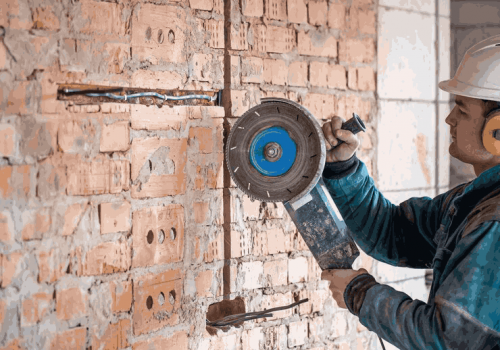Undertaking a concrete removal project involves more than just physical labor and machinery—it requires careful attention to legal considerations to avoid potential pitfalls. Whether you’re a homeowner, contractor, or developer, understanding the legal aspects can prevent disputes and ensure compliance with local regulations. Firstly, zoning and building codes dictate where and how concrete can be removed, often requiring permits depending on the scale of the project. Environmental regulations also play a crucial role, especially concerning the disposal of concrete debris and any hazardous materials it might contain. Secondly, liability issues must be addressed, covering aspects such as worker safety, property damage, and potential impacts on neighboring properties. By navigating these legal nuances early in the planning stages, stakeholders can mitigate risks and ensure that their concrete removal project proceeds smoothly and within the bounds of the law.
Before embarking on any concrete removal project, it’s crucial to navigate the complex web of permits and regulations that govern such activities. From environmental considerations to local zoning laws, understanding and complying with these legal requirements are essential for a successful and lawful project execution.
The first step in any concrete removal project is identifying the permits required. Depending on the location and scope of the project, permits may include environmental permits, demolition permits, and possibly noise or traffic permits. Each jurisdiction has its own set of requirements, so it’s important to research and consult with local authorities to ensure compliance. To begin with, identifying the necessary permits is crucial to avoid legal complications later on. Environmental permits are typically required to ensure that the removal process does not harm the surrounding ecosystem.

Many jurisdictions require an environmental impact assessment (EIA) before issuing permits for concrete removal projects. This assessment evaluates the potential environmental effects of the project and may include studies on air quality, water pollution, and wildlife habitats. Compliance with these assessments is crucial for obtaining permits and avoiding legal challenges during or after the project. Environmental impact assessments play a critical role in ensuring that concrete removal projects are conducted in an environmentally responsible manner.
Local zoning and land use regulations dictate where and how concrete removal projects can be conducted. These regulations may restrict certain activities in residential, commercial, or industrial areas and may require special permits or variances for projects that do not conform to zoning ordinances. Understanding and complying with these regulations are essential for avoiding fines, project delays, or legal disputes. Zoning and land use regulations govern the permissible uses of land within a jurisdiction and play a crucial role in determining where concrete removal projects can take place. These regulations often designate specific zones for residential, commercial, industrial, and recreational purposes, each with its own set of rules and restrictions.
In areas with historical significance or cultural resources, additional permits and regulations may apply to concrete removal projects. These regulations aim to protect valuable historical sites, archaeological artifacts, or culturally significant structures from damage or destruction. Contractors may need to conduct archaeological surveys, obtain permits for work near historical sites, or adhere to specific preservation guidelines to comply with these regulations. Historic preservation and cultural resource regulations are designed to safeguard the historical and cultural heritage of communities. In areas with significant historical sites or cultural resources, such as archaeological sites, ancient structures, or culturally significant landmarks, contractors must adhere to strict preservation guidelines.
Concrete removal projects involve inherent risks to workers’ health and safety. Compliance with occupational health and safety regulations, such as those set forth by the Occupational Safety and Health Administration (OSHA), is crucial for protecting workers from injury and ensuring legal compliance. Contractors must implement safety protocols, provide personal protective equipment (PPE), and conduct regular safety inspections to mitigate risks and prevent legal liabilities.
In the realm of concrete removal projects, legal disputes can occasionally arise despite meticulous planning and adherence to regulations. Handling these issues with a focus on amicable resolution not only preserves business relationships but also ensures projects stay on track without costly delays or litigation. Here’s a comprehensive guide on how to navigate and resolve legal issues effectively in concrete removal projects.
Legal disputes in concrete removal projects can encompass various issues, including contract breaches, scope disagreements, environmental concerns, and safety violations. Understanding these common disputes enables proactive management and mitigation strategies.Legal disputes can arise from various aspects of concrete removal projects. Contract breaches occur when either party fails to fulfill their contractual obligations, such as delays in project completion or substandard workmanship. Scope disagreements may arise when there are discrepancies between what was agreed upon in the contract and what is being executed on-site.
Effective communication is crucial in preventing and resolving legal disputes. Establishing clear channels of communication with all stakeholders, including clients, subcontractors, and regulatory authorities, fosters transparency and reduces misunderstandings. Clear communication is essential throughout all stages of a concrete removal project. Contractors should maintain open and honest communication with clients to ensure that expectations are aligned with project progress and any changes in scope or timeline are communicated promptly. Similarly, subcontractors and suppliers should be kept informed of their responsibilities and any updates to the project schedule or specifications.
Mediation offers a structured approach to resolving disputes outside of the courtroom. By engaging a neutral third-party mediator, both parties can discuss issues, explore solutions, and reach a mutually acceptable agreement without escalating to litigation. Mediation is a voluntary and confidential process where a neutral third-party mediator facilitates discussions between parties to help them reach a mutually acceptable resolution. Unlike litigation, which can be costly and time-consuming, mediation offers a more collaborative approach to resolving disputes. During mediation, both parties have the opportunity to present their perspectives, identify underlying interests, and explore creative solutions that address their concerns.
Arbitration provides a more formal alternative to mediation, where an arbitrator or panel of arbitrators renders a binding decision on the dispute after hearing arguments and evidence from both parties. This method offers a faster resolution than litigation while still providing a structured legal process. Arbitration is a formal dispute resolution process where parties present their cases to a neutral arbitrator or panel of arbitrators who render a binding decision on the dispute. Unlike mediation, where the mediator facilitates discussions and helps parties reach a voluntary agreement, arbitration results in a final and enforceable decision.
Seeking legal counsel early in the event of a dispute is crucial. Experienced construction attorneys can provide legal guidance, assess risks, and advocate on behalf of their clients to achieve favorable outcomes through negotiation, mediation, arbitration, or litigation when necessary. Legal counsel plays a critical role in navigating legal disputes in concrete removal projects.
requirements to prevent accidents and ensure compliance with occupational health and safety standards. Understanding these regulations is essential for maintaining a safe working environment.
Navigating the legal aspects of concrete removal projects is crucial for ensuring compliance, safety, and efficiency. By understanding local regulations, obtaining necessary permits, and addressing environmental concerns, contractors and property owners can avoid potential fines and delays. Clear communication with legal advisors and stakeholders throughout the process is essential to mitigate risks and uphold project timelines. Ultimately, adherence to legal guidelines not only safeguards against liabilities but also promotes sustainable practices in construction and demolition activities.
For expert guidance on legal considerations in concrete removal projects or any inquiries regarding our services, feel free to reach out to JUNKAHAULICS – Raleigh. Located in Raleigh, you can contact us directly at 919-478-4814. Our team is dedicated to providing comprehensive solutions tailored to your specific needs, ensuring compliance and efficiency in every project. Don’t hesitate to call us today to discuss how we can assist you in navigating the complexities of concrete removal while adhering to legal requirements seamlessly.


JUNKAHAULICS